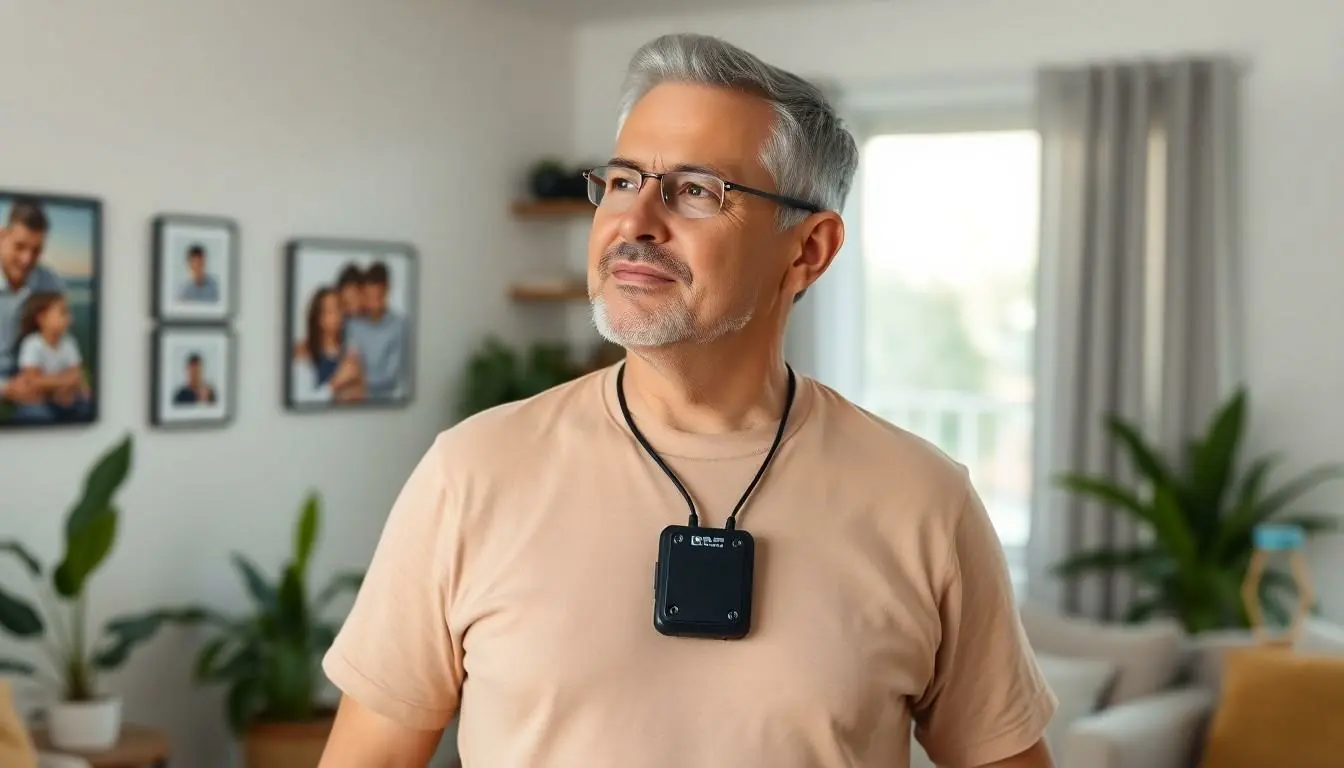Table of Contents
ToggleImagine strapping on a device that not only looks like a high-tech fashion statement but also plays the role of a superhero for your heart. Enter the wearable cardioverter defibrillator, a lifesaving gadget that’s redefining how we think about heart health. This isn’t just another accessory; it’s a personal guardian that monitors your heart rhythm and zaps any pesky arrhythmias back into shape.
In a world where health tech often feels like it’s from a sci-fi movie, this device stands out as a practical solution for those at risk of sudden cardiac arrest. Whether you’re out for a jog or lounging on the couch, it’s got your back—literally. With its sleek design and life-saving capabilities, the wearable cardioverter defibrillator proves that staying heart-healthy can be both stylish and smart. So, let’s dive into how this remarkable device works and why it might just be the best investment for your heart.
Overview of Wearable Cardioverter Defibrillator
Wearable cardioverter defibrillators (WCDs) serve as vital tools for individuals susceptible to life-threatening heart issues. These sophisticated devices continuously monitor a user’s heart activity, promptly detecting irregular heart rhythms. Upon identifying a dangerous rhythm, the WCD administers an electrical shock to restore normal heart function.
Designed for comfort and ease of use, WCDs feature lightweight materials and adjustable straps, enabling wearers to go about daily activities without discomfort. Many users appreciate the discreet nature of these devices, which can blend into regular clothing.
Clinical studies demonstrate that WCDs significantly reduce the risk of sudden cardiac death, particularly for patients with a recent history of myocardial infarction or those awaiting more permanent heart rhythm solutions. The American Heart Association emphasizes the importance of WCDs in bridging the gap for patients at risk while considering other treatment options.
Real-time data transmission to healthcare providers enhances monitoring capabilities, allowing for prompt medical intervention if needed. Many healthcare professionals recommend WCDs as a preventative measure before implantable cardioverter defibrillators become necessary.
Patients value the peace of mind offered by WCDs, understanding these devices provide immediate life-saving options during critical moments. By prioritizing safety and functionality, wearable cardioverter defibrillators play a crucial role in modern cardiology, merging technology with everyday life for proactive heart health management.
How Wearable Cardioverter Defibrillator Works

Wearable cardioverter defibrillators continuously monitor heart rhythms and intervene when necessary. These devices serve as vigilant guardians, ensuring the wearer’s heart health is prioritized.
Detection of Arrhythmias
Wearable cardioverter defibrillators employ advanced sensors to monitor electrical activity in the heart. These sensors detect arrhythmias by analyzing heart rhythms in real time. Upon identifying dangerous irregularities, the device quickly alerts the wearer and healthcare providers. Continuous monitoring is critical, especially for individuals with a recent history of myocardial infarction. Clinical evidence shows that timely detection can significantly impact outcomes in at-risk patients.
Delivery of Therapy
Once an arrhythmia is detected, the wearable device takes immediate action. It delivers a life-saving electrical shock when necessary, effectively restoring normal heart rhythm. The shock is carefully calibrated to minimize discomfort while ensuring efficacy. Immediate therapy can be the difference between life and death, particularly for individuals experiencing sudden cardiac arrest. Studies indicate that swift intervention by a WCD can improve survival rates in emergency situations. This proactive approach enhances overall heart health management.
Benefits of Wearable Cardioverter Defibrillator
Wearable cardioverter defibrillators offer significant advantages for those at risk of sudden cardiac events. These devices enhance safety and improve daily living.
Enhanced Patient Safety
Enhanced patient safety stands out as a primary benefit of wearable cardioverter defibrillators. They continuously monitor heart rhythms, providing real-time alerts for dangerous irregularities. When a life-threatening arrhythmia is detected, the device quickly delivers a tailored electrical shock, restoring normal heart function. This immediate response can drastically improve survival rates during emergencies. Studies indicate that WCDs significantly reduce the risk of sudden cardiac death, especially in patients with recent myocardial infarctions. Healthcare professionals recognize this invaluable role in protecting at-risk individuals, ensuring they have an added layer of safety in their daily lives.
Improved Quality of Life
Improved quality of life is another key advantage associated with WCDs. Comfort and functionality define their design, allowing wearers to engage in daily activities without obstruction. Wearing a WCD provides peace of mind, knowing that heart health is continuously monitored. The discreet nature enables easy integration with regular clothing, enhancing user compliance. Patients often express relief, feeling secure knowing they have immediate access to life-saving measures. Furthermore, the real-time data transmission to healthcare providers fosters proactive interventions, facilitating tailored care when necessary. Overall, these benefits contribute to a confident and active lifestyle for individuals managing heart health risks.
Limitations and Considerations
Wearable cardioverter defibrillators (WCDs) offer significant advantages but also present limitations that users need to consider.
Cost and Accessibility
WCDs can be expensive, often requiring insurance coverage for affordability. The price varies based on manufacturer and features, making it essential for patients to discuss options with their healthcare providers. Many insurances may not cover the full cost, leading to unexpected out-of-pocket expenses. Access to WCDs might also depend on geographic location and available medical facilities. Patients in rural areas might encounter challenges in obtaining these devices promptly. Financial assistance programs sometimes exist but can be complex to navigate. Consequently, understanding the financial implications is crucial for potential users.
Patient Compliance
Patient adherence is vital for maximizing the benefits of WCDs. Comfort and ease of use significantly impact compliance, as many patients may find bulky devices inconvenient. Regular wear is necessary for effective monitoring and intervention, emphasizing the need for a user-friendly design. Patients feeling restricted by the device might avoid wearing it, reducing its life-saving potential. Education about the device’s purpose can improve adherence, instilling confidence in its role during emergencies. Support from healthcare providers plays a crucial role in encouraging consistent use. Overall, addressing compliance challenges can enhance the effectiveness of WCDs in managing heart health.
Future Developments in Wearable Cardioverter Defibrillators
Advancements in wearable cardioverter defibrillators (WCDs) promise enhanced functionalities and user experiences. Integration of artificial intelligence offers predictive analytics, enabling earlier detection of life-threatening arrhythmias. These developments lead to improved algorithms, allowing for more accurate identification of dangerous heart rhythms.
Research focuses on enhancing battery life, aiming for longer usage periods without recharging. Extended battery performance ensures consistent heart monitoring and reliability in critical situations. Moreover, miniaturization of components contributes to a more compact design, further increasing user comfort and wearability.
Collaboration between tech companies and healthcare professionals drives innovation in WCD technology. Partnerships facilitate the development of user-friendly interfaces that simplify data interpretation for patients and doctors alike. Wearers benefit from smartphone applications that allow real-time monitoring and alerts directly on their devices.
Clinical trials will likely expand to include diverse populations, improving the device’s adaptability to various age groups and health conditions. By better understanding patient needs, manufacturers can tailor designs and functionalities that enhance adherence and utilization.
Regulatory bodies continue to evolve their standards, pushing for rigorous testing and validation of new WCD technologies. They strive to ensure safety and efficacy, providing users with confidence in their device’s capabilities.
Emerging telehealth solutions support ongoing patient-physician communication, enabling timely interventions based on monitored data. With remote access to heart rhythm data, healthcare providers can make informed decisions quickly.
Future developments will prioritize not only safety and functionality but also user engagement and education, fostering an environment of proactive heart health management.
Wearable cardioverter defibrillators represent a significant advancement in heart health management. By combining cutting-edge technology with user-friendly design these devices offer critical support for individuals at risk of sudden cardiac arrest. Their ability to continuously monitor heart rhythms and deliver timely interventions can make a life-saving difference.
As advancements continue to emerge in WCD technology the future looks promising. Innovations in artificial intelligence and improved comfort will enhance patient experience and compliance. With ongoing education and support from healthcare providers WCDs will play an increasingly vital role in proactive heart health management. This integration of technology and patient care underscores the importance of these devices in modern cardiology.





